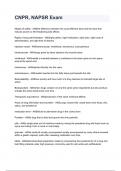RTE 1503 Final exams questions and
answers
How many lobes does the liver have? - with ANSWERS:4: right, left, caudal & quadrate
Falciform ligament - with ANSWERS:Divides the right and left lobes located anterioly
What are the 2 minor lobes in the liver and where are they located? - with
ANSWERS:Caudal and quadratic located posteriorly
How much bile is made in the liver? - with ANSWERS:.5 to 1.5 liters per day
Chole - with ANSWERS:Bile
Cholangio - with ANSWERS:Biliary ducts or structures
Cholecyst or cholecysto - with ANSWERS:Gallbladder
Choledocho - with ANSWERS:Common bile duct (CBD)
cyst or cysto - with ANSWERS:Bladder
Cholelithiasis - with ANSWERS:Condition of having gallstones
Gallbladder procedures - with ANSWERS:1. PTC: Percutaneous Transhepatic
Cholangiography;
2. Post-op or T-tube Cholangiogram;
3. Immediate or operative Cholangiogram
Percutaneous Transhepatic Cholangiography - with ANSWERS:Accesses bile ducts
with "skinny needle" or Chiba through the intercostal rib space for drainage or imaging
purposes
-can cause pneumothorax, punctured liver, hemorrage, sepsis
Post-op or T-tube cholangiogram - with ANSWERS:Exam where T-tube placed during
surgery for drainage
-done to check potency of biliary structures for no leakage
Immediate or operative cholangiogram - with ANSWERS:Common GB imaging study,
watch contrast fill biliary structures, after surgery to check for residual stones and fill
What is the preferred position for gallbladder imaging and why? - with ANSWERS:LAO,
to keep contrast in and move spine away from gallbladder
,Where is the gallbladder in an asthenic patient? - with ANSWERS:Gallbladder near
spine and low
Where is the gallbladder in an hypersthenic patient? - with ANSWERS:Gallbladder up
and near diaphragm, transverse
Chest pathologies - with ANSWERS:Aspiration, atelectasis, bronchiectasis, bronchitis,
COPD, emphysema, metastases, plural effusion, pneumothorax, primary & secondary
tuberculosis, cystic fibrosis
Aspiration - with ANSWERS:Something stuck in the throat. Decrease technical factors
due to soft tissue
Atelectasis - with ANSWERS:Collapsed lung, partial or whole
-increase technique: absence of air
Bronchiectasis - with ANSWERS:Dense fluid in bronchiole in lower respiratory system
-Patient. Can cough it out on trendelenburg; no technique change
-same as Bronchitis
COPD - with ANSWERS:Culmination of 2 disease or more: lower technique due to air
trapped in lungs
Emphysema - with ANSWERS:Ruptured alveoli that has air stuck in them are dense
and black: lower technique
Bulla - with ANSWERS:Group of ruptured aveoli
Metastases - with ANSWERS:Secondary cancer spread from primary source.
-can be Osterlytic or additive: type unknown until X ray done
Osterlytic - with ANSWERS:Destructive: increase technique
Osteoblastic - with ANSWERS:Additive: decrease technique
Plural effusion - with ANSWERS:Fluid in the pleural cavity: increase technique
Pneumothorax - with ANSWERS:Air in pleural cavity: decrease technique
Secondary tuberculosis - with ANSWERS:TB in the upper lungs: decrease technique:
additive
Which position should the patient be in order to view secondary tuberculosis? - with
ANSWERS:AP lordotic or lindblome
, Cystic Fibrosis - with ANSWERS:Common inherited desease in which heavy mucus
secreations cause clogging of bronchi and bronchioles. Additive condition: increase
technique
Upper GI pathologies - with ANSWERS:achalasia, Barrett's esophagus, Zenker's
diverticulum, and hiatal hernia,
achalasia - with ANSWERS:disease of the esophageal sphincter, a neurological motor
disorder of nerves in the esophagus, food gets stuck
-"rat tail"
Barrett's esophagus - with ANSWERS:esophageal lining changes to smooth muscle
and narrows, results of having GERD for a long time, can develop into esophageal
cancer
Zenker's diverticulum - with ANSWERS:outpouching of the esophageal walls just above
the esophageal sphincter. Caused by weakening of the muscle wall
hiatal hernia - with ANSWERS:gastric bubble of protruding aspect of stomach. Can be
small or large, produces Schatzki's ring
Which upper GI pathology is most commonly found in UGI imaging? - with
ANSWERS:Hiatal Hernia
Crohn's disease - with ANSWERS:autoimmune disease in small intestine with walls
inflamed. "String sign" or "cobblestone" appearance
aka regional enteritis
Lower GI pathologies - with ANSWERS:Crohn's disease, Meckel's diverticulum,
ulcerative colitis, intussusception, volvulus, diverticulosis, and annular carcinoma
Meckel's diverticulum - with ANSWERS:Congenital outpouching of small bowel
What is the best way to diagnose Meckel's diverticulum? - with ANSWERS:Nuclear
Medicine, Barium will not show
ulcerative colitis - with ANSWERS:-Inflammatory bowel disease that involves only the
colon and rectum. No haustra, "lead pipe" or "stovepipe" appearance. Common is ages
18-25
intussusception - with ANSWERS:Telescoping of the intestines, "Mushroom cap", low
pressure BE with air to correct, caused by peristalsis
volvulus - with ANSWERS:A twisting of the bowel on itself, causing obstruction. "beak-
like" appearance, intestines twist unto itself






